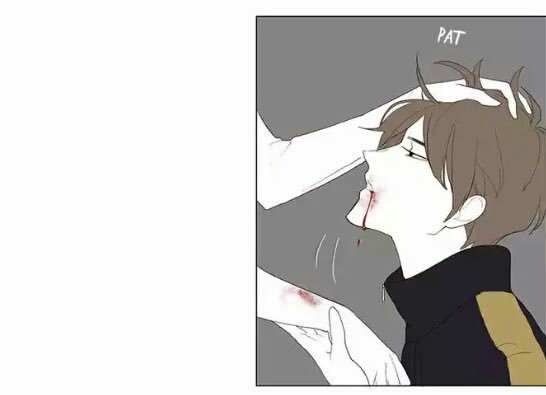Chapter Three: The Ways of Magic
We're 65 pages into the book and haven't had more than two sentences of actual mechanics yet. This chapter is the aforementioned "spellbook" portion, where they list all the new Thaumaturgy paths. But before that...
Learning Thaumaturgical Paths - Most of these rules default to "oral sex the Storyteller harder,"
and this is no different. The rules basically say that to learn a Path you either need access to a mentor or "occult materials that hold lore essential to deciphering the magic." In D&D and Shadowrun and any other reasonable game, they'd just qualify this as "a grimoire," but this is WOD!
Creating New Thaumaturgy Paths - Requires at least Occult 5, Thaumaturgy 5, a haven with a laboratory, and then
copious oral sex. <cough> Okay, they want you to write out all the Path powers, get the Storyteller to sign off on them, and then begin a series of Extended Rolls...
The thaumaturge then begins an extended action, rolling Intelligence + Occult (difficulty 5 + the level she's researching) and requiring five successes. Ever time a player makes this roll, she must also spend five blood points per every level of the power she's researching. These blood points need not necessarily come from her immediately, but she must have them readily available (it's assumed that she consumes them and spends them as necessary during the research). Each roll represents one year of research and experimentation, with success allowing the character to develop a single level of the path. Each level of the new path repeats this process and levels are researched sequentially. A character may not learn the next level of a new path without researching and creating it first. A botch on any given roll resets the successes garnered for the creation of a path's level to zero.
While this technically doesn't make researching Paths impossible, it effectively puts them out of the reach of player characters
because it takes at least five years to research a full Path. Imagine the poor bastard that spent a year and probably bled out a dozen sheep learning how to boil water. I mean sure, you're immortal, but damn.
Also, you have to pay 7 XP for the first level and 4 x (New Level) for each level thereafter.
Now, I
will say this about Path research: the fact that you can research Paths at all, and that it is hinted elsewhere on here that some Paths have alternate powers, actually gives rise to the tantalizing possibility that
maybe you can have paths with more than just five powers. This should not have been a hard sell. The whole point of Thaumaturgy is that you buy a Path with the powers you want, if you can then just buy the powers within the Path that you want for a given level, that's just one more drop-down menu to sort through. Seriously, imagine if they'd adopted that for other powers! You get a macro-discipline like Protean, with Paths like Shapeshifting and Path of the Beast, and when you buy up Level 3 Shapeshifting you get to pick if you want to be a bat or a wolf or whatever - and if you want to turn into more than one
you buy another power at the same level!
I know, I know, we've gone over this. It's just...the pieces were there for a better game.
New Thaumaturgical Paths
There are 11 new Paths in this section. I can't tell if they're all written by the same person, and some are refurbished, but they are:
- Alchemy
- Biothaumaturgy
- The Focused Mind
- The Hearth Path
- Mastery of the Mortal Shell
- Oneiromancy
- Path of the Blood's Curse
- Path of Curses
- Path of Transmutation
- The Vine of Dionysus
- The Faux Path
We won't go into every power, but let's hit the highlights:
Alchemy -
Not what it says on the tin, and they actually start out by telling you that modern technology has largely made this path redundant. This is because it sucks. The Path of Alchemy lets you manipulate elements, but the internal logic involved is bizarre and sometimes contradictory. You can turn lead into gold, for example, but if you try to actually cast the gold into coins it melts into worthless crap because it's not
real gold, but some alchemic ideal. But you can turn water into breathable oxygen. Part of this is a pro-active nerf to prevent players from creating their own fissile material, and part of this is a reactive nerf to the Path of Conjuring.
Biothaumaturgy - Should probably have been a set of rituals instead of a Path, this allows you to create Frankenstein's Monsters...sortof. You're basically playing "creative taxidermist" and bringing the resulting creations to rude unlife, which has serious shades of Necromancy to it - but nobody cares, because Biothaumaturgy takes
weeks. You basically become the mad scientist behind Prometheans. Sortof. Biothaumaturgy is at least potentially one of the more broken paths, since your creations require no vitae upkeep and can basically be put together from scraps of your last meal. Good way to generate chaff for PCs to fight through, anyway.
The Focused Mind - OMG, hax. Seriously though, this is the Path that gets a lot of people hot and bothered. None of the powers require any action to activate: 1st level gives bonus dice for Wits rolls, 2nd level removes penalties, 3rd level should be Dominate power that makes the subject super-focused on what they're doing, 4th level lets you take an extra action per turn (as long as it's mental), and 5th level reduces all difficulties for a scene. While they all have their advantages (keeping in mind how bullshit the WoD dice system is), the one people actually tend to care about is the level 4 power, which lets you, say, throw a fireball at someone and then hit them. Or throw two fireballs. Whatever meets your fancy, really. It's sufficiently threatening that I'm pretty sure White Wolf tried to nerf
Celerity so you don't give yourself ten actions a turn or something.
The Hearth Path - Should just be a collection of rituals, which is what the Path itself says it started out as. This is because it's just a collection of effects for protecting your haven. Low utility for PCs, who probably aren't used to having to booby trap their crib, slightly higher utility for NPCs because the PCs can fully be expected to break in. High-level powers get weird, where you seriously ask your toilet who did the double-decker, but whatever.
Mastery of the Mortal Shell - Basically, this is supposed to be controlling your opponent's body. Which is fun, but the first three levels require you to touch your opponent and so probably aren't happening. Notably I doubt they ever playtested the level 5 power, which appears to be an automatic success as long as the subject is in sight - fun way to win
certamen, just take control of your opponent and have them walk out of the circle.
Oneiromancy - The Tremere
antitribu had the Path of Morpheus for dream/sleep magic, and as of Revised all those dudes are dead, so now this version of dream/sleep magic is kosher again. Or something. It's mostly just level after level of divination, which is kinda sucky when the original Gift of Morpheus let you put targets to sleep - something that would actually let you feed from a victim, which Thaumaturgy powers are usually sucky at.
Path of the Blood's Curse - This is basically a grab-bag of five vampire-specific curses for causing difficulty to your opponent but not, y'know, actually killing them. That makes them less than ideal. Should probably have just been a collection of rituals.
Path of Curses - As above, but applies to non-vampires and vampires alike; curses still mostly suck.
Path of Transmutation - Like the Path of Alchemy but instead of changing
what it is, you change what
state it is in. So you can solidify the blood in somebody's goblet, or you can solidify a river and walk across it (well, no, you can't do that because of hard volume limits, but you
should be able to do that), or you can turn stone liquid and let it harden again around somebody's ankles. The 5th-level power lets you walk through walls, which is a neat trick.
The Vine of Dionysus - Most vampires can't drink...wine, but they can take this Path, which lets you give others all the effects of being drunk. Which could potentially help in feeding, I guess. The 5th level power lets people literally get drunk on your blood, which 1) seems like overkill, given the blood bond, and 2) seems very inefficient, blood-spendage wise.
The Faux Path - For whatever reason, this two-page path is set off in its own section. I think this is because one of the other guys wrote it, did not get the memo about how these things were to be formatted, and they just folded it in anyway. Anyway, this incredibly shitty Path lets you play poker with other vampires by doing things to make them
think you have Disciplines you do not actually have. They spend quite a lot of words explaining how this works, none of which you care about because it literally amounts to a giant game of bluff...and if you wanted to do that, why not just play a Ravnos? (Oh, right, they're all dead...) But seriously, this is over-complicated Chimerstry for people that don't want to actually accomplish anything. I can see how an NPC might use this to seem like a much bigger threat to the PCs than they are, but any PC playing with this is going to get their bluff called fair quick.
Looking back, there's a surprising lack of combat viability for most of these paths. I think that was probably intentional, but it has the downside in that the ultimate utility for these paths is also very low compared to the main book or its sequel
Blood Sacrifice (possibly coming soon to an OSSR near you!)
Rituals of Thaumaturgy
Rituals started out really simple, got out of hand because they were easy to write and nobody bothered to keep track of mechanics, and then got hit by successive passive-aggressive attempts to nerf them. Case in point, in this section they claim the higher the level of the ritual, the more time it takes to learn (one week for Level One, one year for Level Five), and they try to encourage you to spend XP for the privilege...fuck that...and add in Occult Library as a background, which is quickly forgotten. Backgrounds in Vampire are either made of suck or awesome, there is no in-between.
There's really no reason why White Wolf couldn't have gone the full grimoire route, and had a
Books of Blood supplement which detailed ten grimoires, each of which describes one Path and a handful of Rituals. That worked so well for AD&D in
Pages from the Mages that they did three or four books like that. It's an easy and appropriate way of introducing both new mechanics/powers and how to access them, while providing story hooks for Storytellers to drop it in their campaign along the way. Did they do that? They did fucking not.
Creating New Rituals works a lot like creating new Paths, but based on little tell-tale differences in the language I think was written by a completely different person. Instead of each roll taking one year, for Rituals each roll takes "one Season." I don't know how that works in Massachusetts which only has Autumn, Winter, and Road Repair, but whatever.
Rituals...I'm not going through all of these. Most of them you don't care about. A few of them cross the boundary into what should be other blood sorcery disciplines: Learning the Mind Enslumbered (Level 1) lets you learn why a vampire is in torpor or how it died its final death. Probably the most useful are Sanguineous Phial (Level 1), which lets you store blood without spoiling and Extinguish (Level 2) which lets you extinguish flames (size not specified). Sense the Mystical (Level 1) is basically a stand in for Thaumaturgical Sight, a combo power with Auspex. Blood Mead (Level 2)...lets you make bloody honey wine, and Trima (level 2) lets you make bloody spiced wine (did somebody have a homebrew Dionysus cult when writing this book?).
Then there's this one:
Cleaning of the Flesh
Vampires must drinkt he blood of mortals in order to survive and, accompanying this bane is the risk of becoming addicted to mortal vices: illegal narcotics and alcohol. In some cases, Kindred lead their unlives as hosts to a number of sexually transmitted disease, such as AIDS. The Warlock casting this ritual must spend one full night in a bathtub filled with purified water. Throughout the night, the thaumaturge must expunge all but the smallest drop of his blood from his body, a little at a time over the course of one night. As the blood is released from the body, all addictions and diseases the vampire formerly housed will no longer burden him.
System: The caster lies in a vessel of purified water and bleeds out all but one of his blood points, roughly two points an hour. All addictions to drugs and all diseases that are not supernatural in nature will no longer hinder the thaumaturge beginning at night's end, though he will likely be quite ravenous after performing the ritual. This ritual may be performed on another, who must open his own veins, with the Warlock chanting beside the tub.
On the surface, this is stupid: as Frank ranted well in the
Kindred of the Ebony Kingdom OSSR, blood-borne illnesses do not work well in room-temperature corpses. On the other hand, this is
great...for ghouls...provided you can get them to survive it. That last part might be tricky, given the rules for humans and damage vis-a-vis blood loss.
Major Creation (Level 3) sounds like a D&D spell and it sortof is? It's really a way of expanding the Path of Conjuring limit on items you can conjure, at the expense of a thumb (no word on if the thumb grows back, or if you can use Vicissitude to graft extra thumbs on you to use this ritual/power more often).
The Curse Belated (Level 4) is a nice trick: it's cast on a ghoul, and if the ghoul dies, they immediately become a vampire. That's the kind of thing the Giovanni would really get a kick out of as a kind of insurance policy.
Stolen Kisses (Level 4) lets you suck blood through something other than biting the victim. Strong handshakes are mentioned. Choking is mentioned. Sex is specifically mentioned, which is way past ew.
Sculpting the Perfect Servant (Level 5) lets you manipulate the fetus inside a pregnant woman to it's a superbaby, with exceptional attributes, long lifespan, and ready to be ghouled. Somebody has a fetish.
Vires Acquirit Eundo (Level 5) is basically like the AD&D spell
permanency, in that it is supposed to extend the effect of another ritual. Of course, it has no mechanics besides "Storyteller decides what it does," so it is in effect useless.
Higher level rituals are bullshit set dressing because your PC will never cast them; they're the things that NPCs are attempting that PCs interrupt. That said, the four rituals here aren't worth much.
Refined Digestion (Level 6) is a curse that makes non-Kindred blood worth less to the victim (i.e. for every 3 points drunk, you get 1). Sucks, but only from an economy of blood standpoint.
Bone of Eternal Thirst (Level 7) makes a magic bone-weapon that causes aggravated damage and drinks blood. ("Storytellers, beware of players that would carve bone claymores.")

Eyes of the Ever Vigilant (Level 7) enchants a building for a decade so Kindred within aren't affected by Obfuscate, Chimerstry, and some applications of Dominate. Caveat: requires the eyes of seven lying vampires.
Blade of the Forbidden Flower (Level 8) turns a vampire into an enchanted weapon that has all of her powers. This is Samuel Haight level hax, but you'll never get to do it yourself, so...meh.
That's basically it. I skipped a few rituals, because they were extra meh. Rituals literally have no limits and no well-defined boundaries, so it's all Calvinball anyway.
Next up:
Chapter Four: Eldritch Sorceries





